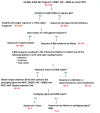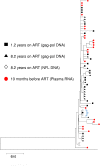Intact HIV Proviruses Persist in Children Seven to Nine Years after Initiation of Antiretroviral Therapy in the First Year of Life
- PMID: 31776265
- PMCID: PMC6997763
- DOI: 10.1128/JVI.01519-19
Intact HIV Proviruses Persist in Children Seven to Nine Years after Initiation of Antiretroviral Therapy in the First Year of Life
Abstract
In adults starting antiretroviral therapy (ART) during acute infection, 2% of proviruses that persist on ART are genetically intact by sequence analysis. In contrast, a recent report in children treated early failed to detect sequence-intact proviruses. In another cohort of children treated early, we sought to detect and characterize proviral sequences after 6 to 9 years on suppressive ART. Peripheral blood mononuclear cells (PBMC) from perinatally infected children from the Children with HIV Early antiRetroviral (CHER) study were analyzed. Nearly full-length proviral amplification and sequencing (NFL-PAS) were performed at one time point after 6 to 9 years on ART. Amplicons with large internal deletions were excluded (<9 kb). All amplicons of ≥9 kb were sequenced and analyzed through a bioinformatic pipeline to detect indels, frameshifts, or hypermutations that would render them defective. In eight children who started ART at a median age of 5.4 months (range, 2.0 to 11.1 months), 733 single NFL-PAS amplicons were generated. Of these, 534 (72.9%) had large internal deletions, 174 (23.7%) had hypermutations, 15 (1.4%) had small internal deletions, 3 (1.0%) had deletions in the packaging signal/major splice donor site, and 7 (1.0%) were sequence intact. These 7 intact sequences were from three children who initiated ART after 2.3 months of age, one of whom had two identical intact sequences, suggestive of a cell clone harboring a replication-competent provirus. No intact proviruses were detected in four children who initiated ART before 2.3 months of age. Rare, intact proviruses can be detected in children who initiate ART after 2.3 months of age and are probably, as in adults, maintained by clonal expansion of cells infected before ART initiation.IMPORTANCE There are limited data about the proviral landscape in children exhibiting long-term suppression after early treatment, particularly in Sub-Saharan Africa where HIV-1 subtype C predominates. Investigating the sequence-intact reservoir could provide insight on the mechanisms by which intact proviruses persist and inform ongoing cure efforts. Through nearly full-length proviral amplification and sequencing (NFL-PAS), we generated 733 NFL-PAS amplicons from eight children. We showed that rare, genetically intact proviruses could be detected in children who initiated ART after 2.3 months of age. The frequency of intact proviruses was lower (P < 0.05) than that reported for HIV subtype B-infected adults treated during early HIV infection. We show that cells harboring genetically intact HIV proviruses are rare in children exhibiting long-term suppression after early treatment and may require the processing of a large number of cells to assess reservoir size. This points to the need for efficient methods to accurately quantify latent reservoirs, particularly in pediatric studies where sample availability is limited.
Keywords: HIV cure; HIV early ART children; HIV full-length sequencing; HIV intact provirus; HIV persistence; HIV persistence children; HIV proviral landscape; HIV reservoir; HIV reservoir decay; human immunodeficiency virus.
Copyright © 2020 American Society for Microbiology.
Figures



Similar articles
-
Sequence Evaluation and Comparative Analysis of Novel Assays for Intact Proviral HIV-1 DNA.J Virol. 2021 Feb 24;95(6):e01986-20. doi: 10.1128/JVI.01986-20. Print 2021 Feb 24. J Virol. 2021. PMID: 33361426 Free PMC article.
-
The replication-competent HIV reservoir is a genetically restricted, younger subset of the overall pool of HIV proviruses persisting during therapy, which is highly genetically stable over time.J Virol. 2024 Feb 20;98(2):e0165523. doi: 10.1128/jvi.01655-23. Epub 2024 Jan 12. J Virol. 2024. PMID: 38214547 Free PMC article.
-
Differences in HIV-1 reservoir size, landscape characteristics, and decay dynamics in acute and chronic treated HIV-1 Clade C infection.Elife. 2025 Feb 20;13:RP96617. doi: 10.7554/eLife.96617. Elife. 2025. PMID: 39976231 Free PMC article.
-
HIV-1 Persistence in Children during Suppressive ART.Viruses. 2021 Jun 12;13(6):1134. doi: 10.3390/v13061134. Viruses. 2021. PMID: 34204740 Free PMC article. Review.
-
New Approaches to Multi-Parametric HIV-1 Genetics Using Multiple Displacement Amplification: Determining the What, How, and Where of the HIV-1 Reservoir.Viruses. 2021 Dec 10;13(12):2475. doi: 10.3390/v13122475. Viruses. 2021. PMID: 34960744 Free PMC article. Review.
Cited by
-
Early Emergence and Long-Term Persistence of HIV-Infected T-Cell Clones in Children.mBio. 2021 Apr 8;12(2):e00568-21. doi: 10.1128/mBio.00568-21. mBio. 2021. PMID: 33832973 Free PMC article.
-
Significance of initiating antiretroviral therapy in the early stage of HIV infection.Zhejiang Da Xue Xue Bao Yi Xue Ban. 2022 Jun 25;51(3):373-379. doi: 10.3724/zdxbyxb-2022-0052. Zhejiang Da Xue Xue Bao Yi Xue Ban. 2022. PMID: 36207834 Free PMC article. English.
-
The HIV-1 antibody response: a footprint of the viral reservoir in children vertically infected with HIV.Lancet HIV. 2020 May;7(5):e359-e365. doi: 10.1016/S2352-3018(20)30100-4. Lancet HIV. 2020. PMID: 32386722 Free PMC article. Review.
-
Divergent populations of HIV-infected naive and memory CD4+ T cell clones in children on antiretroviral therapy.J Clin Invest. 2025 Mar 6;135(9):e188533. doi: 10.1172/JCI188533. eCollection 2025 May 1. J Clin Invest. 2025. PMID: 40048262 Free PMC article.
-
Human models that inform antiretroviral therapy-free remission with perinatally acquired HIV infection.Curr Opin HIV AIDS. 2025 May 1;20(3):249-256. doi: 10.1097/COH.0000000000000918. Epub 2025 Mar 19. Curr Opin HIV AIDS. 2025. PMID: 39946194 Free PMC article. Review.
References
-
- Huang S, Ren Y, Thomas AS, Chan D, Mueller S, Ward AR, Patel S, Bollard CM, Cruz CR, Karandish S, Truong R, Macedo AB, Bosque A, Kovacs C, Benko E, Piechocka-Trocha A, Wong H, Jeng E, Nixon DF, Ho YC, Siliciano RF, Walker BD, Jones RB. 2018. Latent HIV reservoirs exhibit inherent resistance to elimination by CD8+ T cells. J Clin Invest 128:876–889. doi:10.1172/JCI97555. - DOI - PMC - PubMed
-
- Whitney JB, Hill AL, Sanisetty S, Penaloza-MacMaster P, Liu J, Shetty M, Parenteau L, Cabral C, Shields J, Blackmore S, Smith JY, Brinkman AL, Peter LE, Mathew SI, Smith KM, Borducchi EN, Rosenbloom DIS, Lewis MG, Hattersley J, Li B, Hesselgesser J, Geleziunas R, Robb ML, Kim JH, Michael NL, Barouch DH. 2014. Rapid seeding of the viral reservoir prior to SIV viremia in Rhesus monkeys. Nature 512:74–77. doi:10.1038/nature13594. - DOI - PMC - PubMed
-
- Jain V, Hartogensis W, Bacchetti P, Hunt PW, Hatano H, Sinclair E, Epling L, Lee TH, Busch MP, McCune JM, Pilcher CD, Hecht FM, Deeks SG. 2013. Antiretroviral therapy initiated within 6 months of HIV infection is associated with lower T-cell activation and smaller HIV reservoir size. J Infect Dis 208:1202–1211. doi:10.1093/infdis/jit311. - DOI - PMC - PubMed
-
- Ananworanich J, Puthanakit T, Suntarattiwong P, Chokephaibulkit K, Kerr SJ, Fromentin R, Bakeman W, Intasan J, Mahanontharit A, Sirivichayakul S, Chomont N, HIV-NAT 194 Study Group. 2013. Reduced markers of HIV persistence and restricted HIV-specific immune responses after early antiretroviral therapy in children. AIDS 28:1–6. doi:10.1097/QAD.0000000000000178. - DOI - PubMed
Publication types
MeSH terms
Substances
Grants and funding
LinkOut - more resources
Full Text Sources
Medical
Molecular Biology Databases

